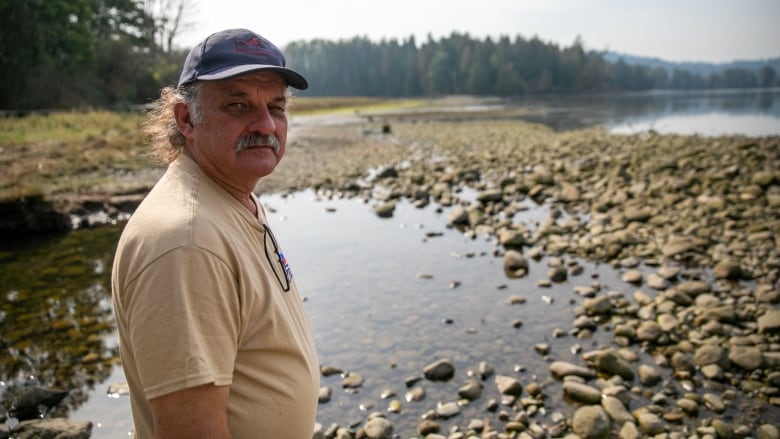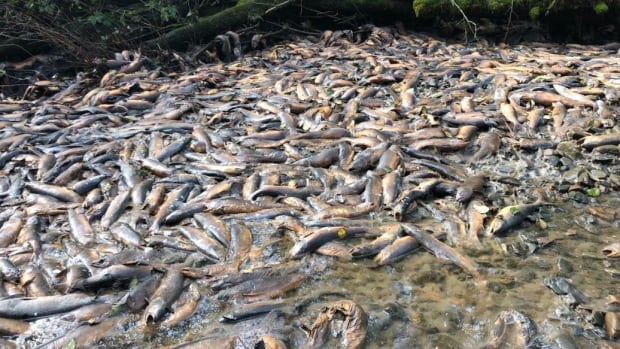After three parched months, much of B.C. is experiencing drought and ongoing hot weather has left streams running dry, leaving no way for some salmon to return to their spawning grounds, killing hundreds in a mass die-off on the province’s central coast.
The situation has scientists and salmon watchers concerned.
The Pacific Salmon Commission initially projected a return of 9.8 million fish this year. By August, predictions were reduced to 5.5 million. This was readjusted again, on Sept. 28, to 6.8 million.
There were record-low rainfalls in September, and dry weather and heat has continued into October, a month known for rain. For some migrating salmon, that lack of moisture is proving deadly.
William Housty, the conservation manager for the Heiltsuk First Nation in Bella Bella, B.C., says crews from his band walk the creek beds and count returning adult salmon.
The number of salmon returning to the Neekas River, about 25 kilometres north of Bella Bella, has been declining for decades, from an average of 47,000 in the 1970s to just 750 in 2021, according to federal data from Fisheries and Oceans Canada.
WATCH | Salmon counters see mass salmon die-off near Bella Bella, B.C.:
Salmon counters for the Heiltsuk First Nation found piles of dead salmon in early October along Neekus Creek.
This year’s drought may have wiped out many more fish when water levels dropped after their return.
This past weekend, researchers discovered piles of lifeless fish – mostly pink salmon — floating dead or plastered together along the bottom of the Neekas near Spiller Channel.
‘Heartbreaking’ scenes of dead fish
Photos and videos taken by German anthropologist Sarah Mund, who was helping Simon Fraser University salmon counters, show what appear to be hundreds of salmon, a few still gasping for air. Many were lying limp over logs or along a creek bed, or floating in shallow, warm waters of a creek that’s usually much deeper this time of year.
“To see it kind of come to this magnitude is quite shocking,” said Housty.
He estimates that if this scene is extrapolated over many creeks, it’s likely hundreds of thousands of fish have died along rivers and streams in their territory this year, due to the warm temperatures and low water levels.
“All of those salmon that are just kind of wasted away and didn’t even have the opportunity to reproduce is just heartbreaking,” said Housty. “It’s sad to watch the wild salmon deteriorate right in front of your eyes.”
Housty said that the full impact of a mass die-off of fish won’t be seen until about 2026, when the adult salmon spawned this year return.

Every fall, salmon return to the rivers where they hatched from eggs and fight upstream to spawning grounds. Females dig a nest and their eggs are fertilized by males who cloud the water with their milt (seminal fluid). Most adult salmon then die, leaving their future to the fry that are able to develop and survive predators.
Kyle Wilson, an applied quantitative biologist with Central Coast Indigenous Resource Alliance, confirmed that the salmon in the videos and stills taken near Bella Bella were mostly pink salmon that had not yet spawned.
While it’s not unheard of for salmon to suffer or die due to low rainfall, Wilson called this mass die-off “abnormal.” He blamed it, in part, on the hot, dry weather, followed by a bit of recent rain that he says “tricked” salmon to head upstream, to their deaths.
He predicts very few pink will survive in this creek — and only in deeper pools higher up the waterway.
“For this generation, there will be a really low rate of return in a couple of years,” said Wilson.
But it may not be a total catastrophe, he says, as pink salmon from other river systems may opt to spawn in the Neekas River.
Until then, Wilson says the loss of the fish will affect predators like bears, wolves and eagles.
It will also affect the commercial and Indigenous fisheries that rely on the salmon that return to wild central B.C. streams each fall.
Other B.C. creeks low, salmon struggling
The same scenario is playing out in other parts of the province that celebrate the return of salmon. Tens of thousands of finger-length salmon fry are released each year from streams into the Burrard Inlet.
Dave Bennie, who has volunteered at the Noon’s Creek salmon hatchery for the Port Moody Ecological Society for 28 years, says “it’s just so abnormal.”
“I don’t know what to say to kids. It’s dry, there’s no water. There’s no fish,” said Bennie. “[I’ve] never seen it this low.”

He points out that salmon are jumping offshore, but the creek bed is so dry that the chum and coho returning can’t get from the ocean into Noon’s Creek to swim upstream to spawn.
“Every year, less and less come back,” said Bennie, while sitting on dry rocks in a creek that he says would usually be flowing as high as his chest by October.
For now, surviving fry hide in the tiny pools below the rocks, but he says that leaves them vulnerable to predators like otters and blue herons, not to mention the unseasonable heat.
Festivals planned to welcome the salmon, Bennie says, may have very few fish to celebrate. He fears for all the Burrard Inlet hatcheries.
“We could lose everything — all the work we’ve done for years and years.”


